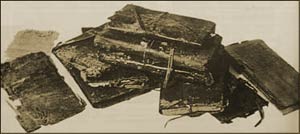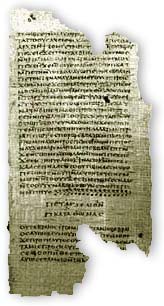Nag Hammadi Library
(Difference between revisions)
|
Revision as of 10:34, 23 Oct 2004 Ash (Talk | contribs) small changes |
Current revision Adityanath (Talk | contribs) |
||
| Line 70: | Line 70: | ||
| ** Trimorphic Protennoia | ** Trimorphic Protennoia | ||
| ** On the Origin of the World | ** On the Origin of the World | ||
| - | |||
| - | ==External links== | ||
| - | *[http://www.gnosis.org/naghamm/nhl.html The Nag Hammadi Library at Gnosis.org] —with an introduction and the full texts | ||
| - | *[http://www.nag-hammadi.com/ The Nag Hammadi Library at nag-hammadi.com] —with stories of its discovery | ||
| ==References== | ==References== | ||
| Line 79: | Line 75: | ||
| *Robinson, James M., ed. ''The Nag Hammadi Library in English'' ISBN 0060669357. | *Robinson, James M., ed. ''The Nag Hammadi Library in English'' ISBN 0060669357. | ||
| *Wikipedia (2004). [http://www.wikipedia.org/Nag_Hammadi Nag Hammadi]. Retrieved Oct. 22, 2004. | *Wikipedia (2004). [http://www.wikipedia.org/Nag_Hammadi Nag Hammadi]. Retrieved Oct. 22, 2004. | ||
| + | |||
| + | ==External links== | ||
| + | *[http://www.gnosis.org/naghamm/nhl.html The Nag Hammadi Library at Gnosis.org] —with an introduction and the full texts | ||
| + | *[http://www.nag-hammadi.com/ The Nag Hammadi Library at nag-hammadi.com] —with stories of its discovery | ||
| + | |||
| + | [[Category:Sacred Texts]] | ||
Current revision
The Nag Hammadi Library is a collection of sacred texts that were discovered by Mohammed Ali Samman in 1945 in the small village of Nag Hammâdi (Chenoboskion in classical antiquity) in central Egypt. The thirteen codices, with fifty-two texts, were found buried in a sealed jar. The writings in these codices are mostly Gnostic treatises, but they also include three works belonging to the Corpus Hermeticum and a partial translation of Plato's Republic. The codices are believed to be a library, hidden by monks from the nearby St. Pachomius monastery when these writings were banned by the Orthodox Church in an effort to eliminate all heterodoxy and heresy.The contents of the codices were written in Coptic, though the works were mostly (all?) translations from Greek. Most famous of these works must be the Gospel of Thomas, of which the Nag Hammadi codices contain the only complete copy. After the discovery it was recognized that fragments of these sayings of Jesus appeared in manuscripts that had been discovered at Oxyrhynchus in 1898, and quotations were recognized in other early Christian sources. The 1st or 2nd century date of the lost Greek originals behind the Coptic translations is controverted, but the manuscripts themselves are from the 3rd and 4th centuries.
[edit]
List of Codices Found in Nag Hammadi
- Codex I (also known as The Jung Codex):
- The Prayer of the Apostle Paul
- The Apocryphon of James
- The Gospel of Truth
- The Treatise on the Resurrection
- The Tripartite Tractate
- Codex II:
- The Apocryphon of John
- The Gospel of Thomas
- The Gospel of Philip
- The Hypostasis of the Archons
- On the Origin of the World
- The Exegesis on the Soul
- The Book of Thomas the Contender
- Codex III:
- The Apocryphon of John
- The Gospel of the Egyptians
- Eugnostos the Blessed
- The Sophia of Jesus Christ
- The Dialogue of the Savior
- Codex IV:
- The Apocryphon of John
- The Gospel of the Egyptians
- Codex V:
- Eugnostos the Blessed
- The Apocalypse of Paul
- The (first) Apocalypse of James
- The (second) Apocalypse of James
- The Apocalypse of Adam
- Codex VI:
- The Acts of Peter and the Twelve Apostles
- The Thunder, Perfect Mind
- Authorative Teaching
- The Concept of Our Great Power
- The Republic by Plato - The original is not gnostic, but the Nag Hammadi library version is heavily modified and therefore gnostic.
- The Discourse on the Eighth and Ninth - a Hermetic treatise
- The Prayer of Thanksgiving (with a hand-written note) - a Hermetic prayer
- Asclepius 21-29 - another Hermetic treatise
- Codex VII:
- The Paraphrase of Shem
- The Second Treatise of the Great Seth
- Apocalypse of Peter
- The Teachings of Silvanus
- The Three Steles of Seth
- Codex VIII:
- Zostrianos
- The Letter of Peter to Philip
- Codex IX:
- Melchizedek
- The Thought of Norea
- The Testimony of Truth
- Codex X:
- Marsanes
- Codex XI:
- The Interpretation of Knowledge
- A Valentinian Exposition, On the Anointing, On Baptism (A and B) and On the Eucharist (A and B)
- Allogenes
- Hypsiphrone
- Codex XII:
- The Sentences of Sextus
- The Gospel of Truth
- Fragments
- Codex XIII:
- Trimorphic Protennoia
- On the Origin of the World
[edit]
References
- Layton, Bentley, ed. The Gnostic Scriptures ISBN 0385478437.
- Robinson, James M., ed. The Nag Hammadi Library in English ISBN 0060669357.
- Wikipedia (2004). Nag Hammadi (http://www.wikipedia.org/Nag_Hammadi). Retrieved Oct. 22, 2004.
[edit]
External links
- The Nag Hammadi Library at Gnosis.org (http://www.gnosis.org/naghamm/nhl.html) —with an introduction and the full texts
- The Nag Hammadi Library at nag-hammadi.com (http://www.nag-hammadi.com/) —with stories of its discovery
![[Main Page]](http://www.thelemapedia.org/images/logo.gif)

